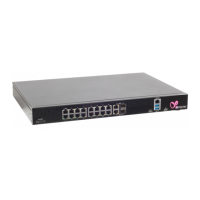Managing the Device
Quantum Spark 1500, 1600 and 1800 Appliance Series R80.20.40 Locally Managed Administration Guide | 55
The 'Configuration' tab
Note - When you change the connection type, the appliance may disconnect from the internet.
n
Connection name - Enter a name for the connection or leave the default "Internet<N>" label (where
<N> indicates an incrementing number).
n
Interface name
n
WAN (IPv4 /IPv6) or DMZ is for most types of Internet connections.
You can configure multiple static IPs over the same WAN interface.
The DMZ port has 2 inputs: LAN(RJ45) and SFP. In non-VDSL 1570 / 1590 appliances, you can use
an external DSL modem connected to the DMZ SFP port. Note - Only Check Point Branded SFPDSL
is supported. Third party SFPDSLis not supported.
Note - DMZ is not supported in 1530 / 1550 appliances.
n
LAN. You can also use unassigned LAN ports with no VLANs for internet connections. When you
delete the internet connection, the port reverts to an unassigned LAN.
n
Link aggregation (Bond) - Create a link between two or more interfaces. This improves performance
and redundancy by increasing the network throughput and bandwidth. A WAN or LAN bond can act
like a regular internet connection in the cluster flow. A WAN bond in a cluster can be a monitoring
interface.
n
USB/Serial is for cellular modems
n
ADSL/VDSL. If you select the ADSL/VDSL interface, you must select one of these for the connection
type: PPPoE, IPoE - static IP, or IPoE - dynamic IP.
You can create a maximum of 32 internet connections. This includes alias IP connections.
Note - If you remove or disable a LAN, any assigned alias IPs are also removed.
Unassigned LAN ports use case - If your company is in a region where internet connections supplied by
ISPs are unreliable and experience multiple disconnections, you can connect your appliances to multiple
internet connections from different ISPs.
To configure an internet connection over the DMZ port:
1. On the Configuring Internet Connectivity page, click New to create a new internet connection.
The New Internet Connection window opens in the Configuration tab.
2. For Interface, select DMZ.
n
For a DSL over DMZ Connection, select SFP-DSL.
n
For a non-DSL connection, select RJ45/SFP-Fiber.
3. Click Apply.
Note – If the appliance has an internal modem, an external modem is not supported.

